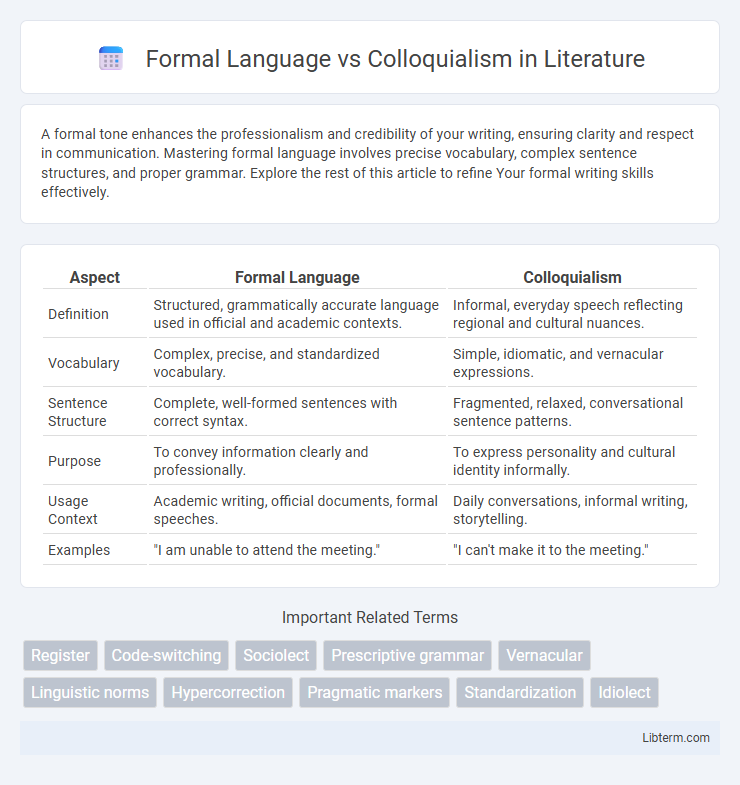A formal tone enhances the professionalism and credibility of your writing, ensuring clarity and respect in communication. Mastering formal language involves precise vocabulary, complex sentence structures, and proper grammar. Explore the rest of this article to refine Your formal writing skills effectively.
Table of Comparison
| Aspect | Formal Language | Colloquialism |
|---|---|---|
| Definition | Structured, grammatically accurate language used in official and academic contexts. | Informal, everyday speech reflecting regional and cultural nuances. |
| Vocabulary | Complex, precise, and standardized vocabulary. | Simple, idiomatic, and vernacular expressions. |
| Sentence Structure | Complete, well-formed sentences with correct syntax. | Fragmented, relaxed, conversational sentence patterns. |
| Purpose | To convey information clearly and professionally. | To express personality and cultural identity informally. |
| Usage Context | Academic writing, official documents, formal speeches. | Daily conversations, informal writing, storytelling. |
| Examples | "I am unable to attend the meeting." | "I can't make it to the meeting." |
Defining Formal Language and Colloquialism
Formal language is characterized by its structured grammar, precise vocabulary, and adherence to established linguistic norms, often used in professional, academic, or official contexts. Colloquialism entails informal expressions, slang, and conversational phrases typical of everyday speech, reflecting regional or cultural nuances. Distinguishing these two forms lies in their purpose: formal language prioritizes clarity and professionalism, while colloquialism fosters relatability and casual communication.
Historical Evolution of Language Styles
The historical evolution of language styles reveals that formal language emerged from standardized grammar and vocabulary used in official documents, literature, and education during periods such as the Renaissance and Enlightenment. Colloquialism, rooted in everyday speech and regional dialects, developed organically as communities sought efficient and informal communication, reflecting cultural identity and social changes over time. The contrast between formal language and colloquialism highlights shifting linguistic norms influenced by technological advancements, social mobility, and globalization throughout history.
Key Characteristics of Formal Language
Formal language is characterized by structured grammar, precise vocabulary, and a lack of contractions or slang, making it suitable for academic, legal, and professional contexts. It emphasizes clarity, objectivity, and politeness, often employing complex sentences and passive voice to maintain an impersonal tone. The consistent use of formal language enhances professionalism and ensures effective communication across diverse audiences.
Hallmarks of Colloquial Expression
Colloquial expressions are marked by their informal tone, use of slang, and region-specific vocabulary, distinguishing them from the structured and grammatically precise nature of formal language. They often include contractions, idioms, and phrasal verbs that reflect everyday speech patterns and cultural nuances. This linguistic style enhances relatability and immediacy, making communication more personal and engaging in casual contexts.
Contextual Appropriateness: When to Use Each
Formal language suits professional, academic, and official contexts where clarity, respect, and precision are essential, such as business meetings, legal documents, and academic papers. Colloquialism thrives in casual conversations, social media, and informal settings where relatability and personal connection are prioritized. Choosing between formal language and colloquial expressions depends on the audience, purpose, and setting to ensure effective and appropriate communication.
Impacts on Audience Understanding
Formal language enhances clarity and precision, promoting better comprehension among academic and professional audiences. Colloquialism fosters relatability and engagement, making content more accessible and culturally resonant for casual or local listeners. Audience understanding depends on context, with formal language reducing ambiguity and colloquialisms enriching emotional connection.
Formal vs Colloquial Language in Writing
Formal language in writing utilizes precise vocabulary, structured syntax, and adheres strictly to grammatical rules to maintain professionalism and clarity. Colloquial language incorporates informal expressions, contractions, and idiomatic phrases that reflect everyday speech, making the text more relatable but less suitable for academic or official documents. Choosing between formal and colloquial language depends on the target audience, purpose, and context of the writing to achieve effective communication.
Influence on Tone and Communication
Formal language employs structured grammar and precise vocabulary, creating a tone of professionalism and clarity essential in academic, legal, or business contexts. Colloquialism introduces informal expressions and regional dialects, fostering a conversational and approachable tone that enhances relatability and emotional connection. The choice between these styles significantly influences communication effectiveness, as formal language upholds authority and respect, while colloquialisms encourage engagement and cultural relevance.
Common Pitfalls and Misconceptions
Formal language often faces misconceptions such as being too rigid or difficult to understand, but its clarity and precision are crucial in professional and academic contexts. Common pitfalls include overuse of jargon, which can alienate the audience, and neglecting tone appropriateness, leading to communication breakdowns. Colloquialism, while engaging and relatable, risks misinterpretation or perceived unprofessionalism if used in formal settings or cross-cultural communications.
Bridging the Gap: Striking the Right Balance
Striking the right balance between formal language and colloquialism enhances effective communication by tailoring tone to context, audience, and purpose. Using formal language establishes professionalism and clarity, while integrating colloquial expressions fosters relatability and engagement. Mastering this blend is essential for writers, educators, and professionals aiming to connect authentically without sacrificing precision or authority.
Formal Language Infographic

 libterm.com
libterm.com